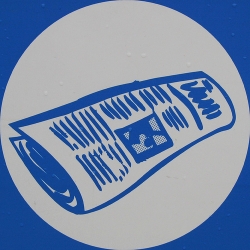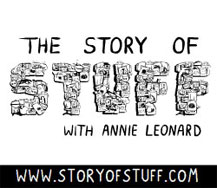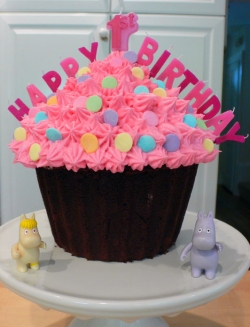 As promised, here is Part 2 of my article for Etsy in The Storque’s new Earth Tones section. Click here to read Part 1. I’d love to hear what you think about these ideas. It feels a little like Christmas around here at Green Options, so… Merry Earth Day!
As promised, here is Part 2 of my article for Etsy in The Storque’s new Earth Tones section. Click here to read Part 1. I’d love to hear what you think about these ideas. It feels a little like Christmas around here at Green Options, so… Merry Earth Day!
Indie crafters have become notable participants in the history of making things, but have a unique opportunity to pioneer social change as well. Since the Industrial Revolution, consumers have been diverted by the science of sales, and derive pleasure largely through conspicuous consumption. I feel that we modern makers seek to lift them out of the doldrums through individual acts of creativity. Yet, as materialism tips nature’s balance, our noble pursuit of culture questions its own validity. There is increasing unrest amongst crafters who feel their creations only add to the clutter on this Earth, but what if we could actually save the world by making things?
Cradle to Cradle: Industry that Benefits Nature
I was awestruck when I saw this Ted Talk (a conference dedicated to innovation in Technology, Entertainment, Design) by William McDonough explaining Cradle to Cradle, a manufacturing standard that promises to “love all children of all species for all time.” I had heard this term and “upcycling” thrown around, but never truly examined the concept. TeenAngster wrote a Stroque article explaining the background of C2C, and how it relates to crafters and makers. What amazes me most is that you don’t need to read the book to be enlightened by the idea. Just take a look around you. Natural systems metabolize their nourishment to sustain themselves and their environment. Humans breath in oxygen that is exhaled as carbon dioxide, which is inhaled by trees and then exhaled as oxygen. Even the most violent explosions in the universe — supernovas — disperse vital elements needed to form new stars and solar systems. During the last one hundred years, humans have excelled at benefiting from nature with little reciprocal effort…all powered by burning the remains of extinct giant lizards and plants aka fossil fuels. Amid alarming changes in our climate, visible pollution, and wide spread health effects, few deny the importance of becoming eco-conscious.
 A lot of perfectly useful raw materials get thrown in the trash every day. Reclaiming items after they have fulfilled their usefulness has never been a factor in design until now. The idea is for our customers put new intentions on belongings, and we can give them motivation to do so.The cradle to cradle philosophy indicates that all man-made materials should be circulated through one of two closed systems in a world without waste. It involves rethinking the way things are assembled, so they may be disassembled. Parts designated as “technical nutrients,” replenish industry infinitely through upcycling or re-purposing, without degrading or emitting harmful toxins. Biological nutrients on the other hand, are derived from sustainable natural resources. They can be thrown on the ground, not only without concern, but to the benefit of the soil.
A lot of perfectly useful raw materials get thrown in the trash every day. Reclaiming items after they have fulfilled their usefulness has never been a factor in design until now. The idea is for our customers put new intentions on belongings, and we can give them motivation to do so.The cradle to cradle philosophy indicates that all man-made materials should be circulated through one of two closed systems in a world without waste. It involves rethinking the way things are assembled, so they may be disassembled. Parts designated as “technical nutrients,” replenish industry infinitely through upcycling or re-purposing, without degrading or emitting harmful toxins. Biological nutrients on the other hand, are derived from sustainable natural resources. They can be thrown on the ground, not only without concern, but to the benefit of the soil.
Amazing, but a pipe dream at best? On the contrary, some large corporations have been embracing the idea, applying it to their architecture, and creating products that fit within C2C certification standards. Ford recently built a prototype vehicle, the Model U, which not only runs on clean hydrogen fuel, but is designed with a basis of technical and biological nutrients. The U.S. Postal Service has taken rigorous steps to certify its Priority & Express mail packaging, and numerous other companies and communities are making bold changes to become “hyper green.”
Upcycled Crafts: Industrial Nutrients 1.0
We know that most microbrands strive on aesthetic consistency. A lucky few have been able to create solid designs out of waste materials that are abundantly saved, such as old electronics. They are actually introducing the nutrient concept right under everyone’s noses. DebbyAremDesigns has been successfully selling her circuit board creations in boutiques across the continent, including the museum shops at the Smithsonian Air and Space Museum and the Boston Computer Museum. It proves that consumers are beginning to place added value on creative reuse.
A New Buyer/Seller Cycle
It’s important to expect green and humane practices from our suppliers, but in this scenario, exponentially more importance is placed on new ideas. There is unmatched resourcefulness within the indie craft movement, so here’s an idea for you… Turning trash into treasure often involves scouring through what others have thrown “away.” Sellers, why not create a direct relationship with consumers to promote participation in upcycling, and have materials we want essentially brought to us?
Certainly, it may take a little while to catch on, but we are in for a long-term incremental transition to non-toxic manufacturing and alternative fuels. While incubating these ideas, I realized that many of them involve little more effort than we invest now to promote our creations.
Here a sketch that should make sense for Etsy members:
The basic format involves sellers having a centralized list of materials they need. They should specify reasonable parameters, such as felt or corduroy instead of just fabric, whenever possible, or indicate other specifics. The list should always provide access to a profile of the artist and what they make. The idea is for our customers to put new intentions on belongings, and we can give them incentive to do so. Each maker would dictate their own system of coupons, give-aways, or other incentives, such as a reduced price if the buyer provides the raw materials. The more generous you are, the more materials you will get, and finding a happy balance may be an interesting challenge.
Local networks and events would be epicenters for this concept. Vanessa coined the possibility of creating a reverse Alchemy/Shop Local/Supplies section on Etsy to facilitate this. I would also love to see Teams introduce the idea of “craftcycle bins” in their communities through promotions and events. Add to that outreach programs for crafters outside the indie realm, and we could significantly reduce the consumption of commercial supplies.
 This would open up an entirely new market for indie entrepreneurs as well. By utilizing the abundance of these resources, they could build vast inventories of refurbished, beautifully consistent supplies and kits. I’ve seen a handful of shops such as claudiascreations and whimsiedots with great examples of creatively reclaimed craft supplies.
This would open up an entirely new market for indie entrepreneurs as well. By utilizing the abundance of these resources, they could build vast inventories of refurbished, beautifully consistent supplies and kits. I’ve seen a handful of shops such as claudiascreations and whimsiedots with great examples of creatively reclaimed craft supplies.
Sellers could even offer to take back their creations to be refurbished, in return for a discount on something “new.”
Through initiatives like these, we could begin to demonstrate a closed system that sustains itself on waste…technical nutrients in action! This concept is being realized from the top down by industry. What if we could create awareness from the bottom up, and meet them in the middle?
Petition the Retailers!
Of course, not all supplies could be sourced this way. Over at Crafting a Green World, we are taking suggestions for an Eco-Crafters List of Demands that will be part of a petition to get the attention of retailers. We want to make it clear to them that we have educated ourselves on environmental matters, and greenwashing will not be tolerated. I should also add that most independent eco-conscious suppliers make genuine efforts at progress towards C2C standards. With all the money we are saving from upcycling, we should be able to patronize them even more.
Eco-Exhibit
I’d also like to propose a craft exhibit that brings awareness to biological nutrients. Artists could contribute signature wares created entirely from non-toxic biodegradable materials, with blue ribbons going to those that make an effort for their item not only to be safe for the ground, but additionally benefit the Earth. For instance, by incorporating seeds or natural plant foods into biodegradable items. Research and outreach will be required to help crafters pinpoint proper materials. Items would be displayed and photographed for a short time, then ceremoniously thrown into a contained garden. The process of disintegration should be documented, taking pictures when any plants bloom that were a part of the wares.
On a final note…
I am continually amazed by what people in this community are making, no matter what their products are made of. My hope is that the information and ideas presented here will only expand our opportunities for creativity and profitability while bringing awareness to more harmonious manufacturing methods. Handmade has its charm, but more importantly, we are striving for a culture abundant with individual expression, respect for our planet…and each other.
Further Resources:
TED Talk: Janine Benyus – 12 Sustainable Designs Ideas from Nature
The Sustainable Textile Standard
InHabitat.com/2007/11/22/cohda-recycling-factory-at-dott-07/
Climatex Lifecycle Fabrics
www.mbdc.com
SustainableStyle.org
I.D.’s Umbrella Inside Out Competition
[clock by DebbyAremDesigns][photo by jhritz][supplies bundled by whimsiedots]










I was wondering where you would take Part 2. Glad to see both Cradle to Cradle and Janine Benyus referenced. You have some very interesting concepts here. I’m not an Etsy artist myself, but I can how your concepts could be applied for the quilting community I belong to.
I was wondering where you would take Part 2. Glad to see both Cradle to Cradle and Janine Benyus referenced. You have some very interesting concepts here. I’m not an Etsy artist myself, but I can how your concepts could be applied for the quilting community I belong to.
I was wondering where you would take Part 2. Glad to see both Cradle to Cradle and Janine Benyus referenced. You have some very interesting concepts here. I’m not an Etsy artist myself, but I can how your concepts could be applied for the quilting community I belong to.
I was wondering where you would take Part 2. Glad to see both Cradle to Cradle and Janine Benyus referenced. You have some very interesting concepts here. I’m not an Etsy artist myself, but I can how your concepts could be applied for the quilting community I belong to.
Pingback: Maker Faire does Green Living : Crafting a Green World